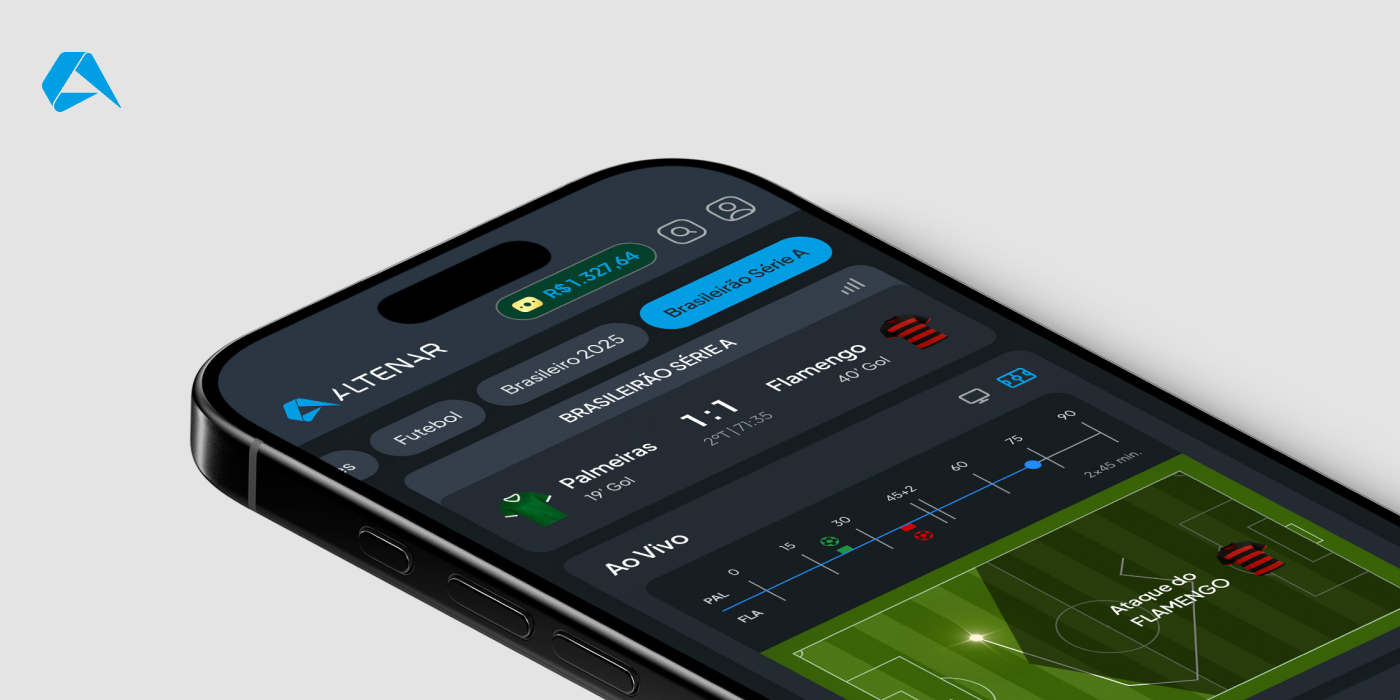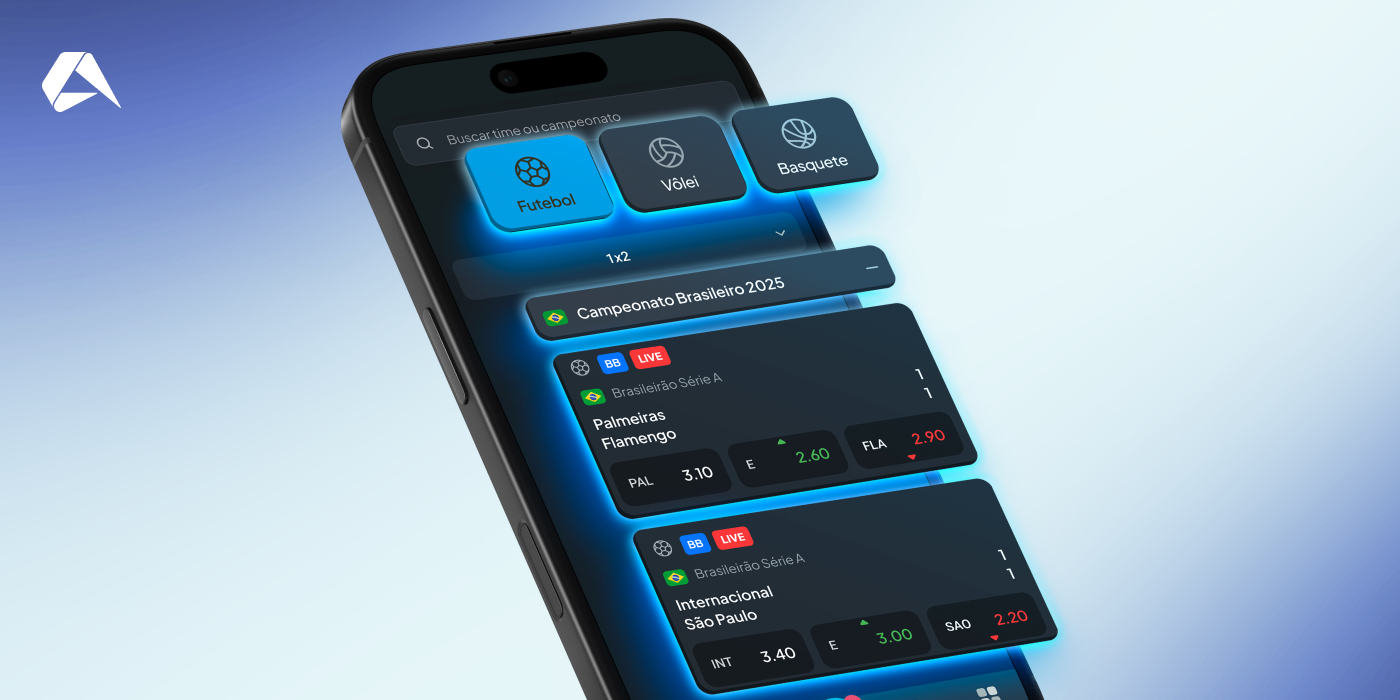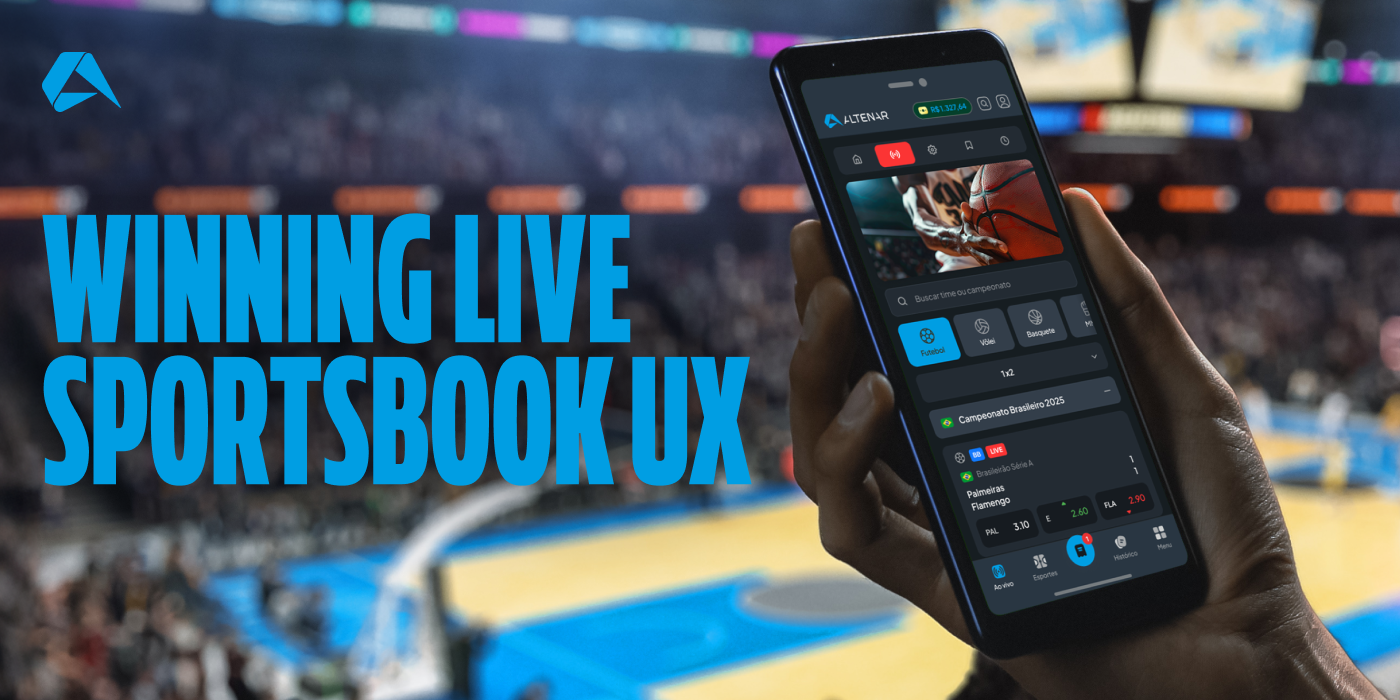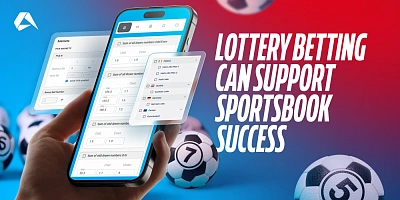Live betting has become one of the biggest drivers of sportsbook revenue, but it’s also one of the hardest areas to master. With the pace of the action, dynamic odds, shifting markets and the mobile-first experience, live betting places very different demands on the user experience (UX) compared to pre-match betting.
And yet, many platforms still carry old design assumptions into the live betting experience. The result is a series of missed opportunities, frustrated players, and underperformance where margins should be the strongest.
This article looks at what makes great live UX work. From key principles to common pitfalls, we uncover the advanced methods and tools operators are using to improve the live betting experiences in today’s sports betting arena.
Why Live Betting Demands a Different UX Approach
It’s easy to think of live betting UX as an extension of the sportsbook experience, just faster, with more markets and constant odds movement. But that view underestimates how different the player's mindset really is once the game is under way.
Pre-match betting is still relatively methodical. Players compare odds, weigh markets, and consider value. In live betting, that behavior alters entirely. It becomes instinctive, opportunistic, and generally heavily influenced by the flow of the match or tournament taking place. Decisions happen in seconds, often mid-play, sometimes triggered by fast-changing events or emotions. The user experience, therefore, has to serve this altered state.
What this essentially means is that what works for browsing static markets or building an accumulator often works against you in live betting. The player doesn’t want layers of navigation or dense tables. They want immediate access, clear calls to action, and the ability to execute a decision before the moment is lost.
And because live markets evolve rapidly, driven by real-world actions and often accessed via mobile devices, even the slightest resistance in the user experience can impact engagement. That’s why live betting UX must be designed from the ground up, not bolted onto existing sportsbook frameworks. The difference is subtle in places, but operationally, it’s everything.
Core Principles of Great Live Betting UX

Once we stop thinking of live betting as merely a sportsbook add-on, the real question becomes what should great live UX actually deliver? And what outcomes matter most to operators and players?
At its core, good live betting UX serves three things; speed of decision, clarity of opportunity, and depth of engagement. If those three elements aren’t working in harmony, the product will most likely underperform, no matter how good the underlying markets or pricing may be.
Speed of decision means removing friction. Bettors must be able to spot a market, evaluate it instantly, and place their bet before the window closes. That requires intuitive design, minimal clicks, and no unnecessary hesitation points.
Clarity of opportunity means displaying the right markets and odds at the right moments, and not bombarding the player with irrelevant options. Fundamentally, it’s about shaping attention in a constantly changing environment.
Depth of engagement means encouraging players to stay connected to the event and the sportsbook, offering an experience that feels in the moment, reactive, and rewarding.
When live UX gets this right, the commercial impact is usually immediate. Operators can expect higher turnover, stronger margins, and better player retention. Bettors stay active for longer, place more bets per session, and develop stronger brand loyalty around an experience they trust.
But when the experience falls short, even on a technically sound platform, operators typically see the opposite. Lower in-play participation, early session abandonment, and a sharp drop-off in repeat engagement. Consequently, the opportunity exists in the margins of design, where small decisions in flow and clarity can turn a solid live product into a top-performing one.
Speed Is Everything. But It’s Not Just About Loading Times
Speed really does change everything in live betting, but far too often, operators think only in terms of page load times or data refresh rates. Technical speed matters, of course. If odds updates lag or bet placement stalls, players will drop out fast. But what’s equally important, and often more decisive, is the user’s perceived speed. That’s to say, how fast the experience feels to the bettor in the moment.
That perceived speed is shaped by UX decisions. How many clicks or taps does it take to place a bet? How intuitive is the market hierarchy? Does the layout guide attention, or force players to hunt for key information? In a live betting environment, hesitation costs money, and poor interaction flow is one of the most common hidden points of friction in underperforming products.
Another factor is decision overload. When too many markets, stats, or dynamic elements compete for attention, users slow down. Put another way, bettors have a limited amount of mental bandwidth, especially during a game and when using mobile devices. Good live UX reduces that load, helping them stay sharp and reactive.
There’s also the question of pacing. Some layouts inadvertently disrupt the natural rhythm of betting by forcing unnecessary page transitions or modal pop-ups. These breaks in flow can be fatal to in-play engagement.
In short, great live betting UX isn’t just about being fast on a stopwatch. It must feel fast to the player. That’s what keeps them fully engaged when the action is moving at breakneck speed on the field.
Designing for Mobile-First Live Betting

It’s no secret that live betting has become a mobile-first experience in most markets, but designing for that reality takes more than simply scaling down the desktop site.
When the action is live, mobile users expect rapid interaction and demand an interface that allows them to move quickly with minimal effort. This is where many operators fall short. A cluttered screen, an extra swipe, or unclear navigation can derail the user’s flow at the very moment they’re most likely to bet.
Good mobile-first live UX is about pace and flow. The most relevant markets need to be immediately accessible. Bet placement must feel effortless, ideally achievable in one to two taps from the event screen to confirmation. Key betting actions (such as quick bet, one-click confirmation, or fast cash-out) should be intuitively accessible and not buried in layers of navigation.
Screen layout also plays a role. On smaller devices, stacked menus and modal overlays can slow bettors down. Horizontal scrolling, when used effectively, can create a more natural browsing experience that keeps users engaged in the moment.
Finally, everything must feel stable and reliable under pressure. In live play, odds move fast, but UI elements shouldn’t jump or reflow (when on-screen elements shift position as live data updates) unexpectedly. Predictability and flow make the difference between a seamless experience and one that loses the player’s attention before the next market even appears.
Regional Variations in Mobile Behavior
While mobile-first principles apply everywhere, betting habits and UX expectations still vary somewhat by region. Design choices that resonate with players in one market can feel awkward or unfamiliar in another.
Here’s a quick snapshot of how live betting behavior and mobile UX preference tend to vary across key regions:
| Region | Device Preference | Typical Betting Rhythm | UX Notes |
|---|---|---|---|
| Europe | High mobile usage, but still strong desktop presence for serious bettors | Mixed, fast single bets and longer in-play sessions | Clean UI, quick bet slip access, minimal animations preferred |
| Asia | Predominantly mobile-first, often very fast-paced | Rapid-fire betting, often multiple live bets per event | Speed-critical, lightweight design, limited navigation depth |
| LatAm | Heavy mobile usage, devices vary widely in performance | Shorter sessions, opportunistic live bets | Simple UI, clear calls to action, scalable across lower-end devices |
| North America | A growing mobile-first trend, especially among younger demographics | In-play is still building, focus on key moments (timeouts, breaks) | Intuitive design, educational prompts for new in-play bettors |
For operators seeking to delve deeper, regional layout choices, along with the UX thinking behind them, are explored in more detail across Altenar’s market-specific layout guides, covering Italy, Europe, the USA, North America, and Africa. These can be a helpful reference when planning market-localized live betting experiences.
Balancing Information Density and Player Focus
One of the hardest design challenges in live betting UX is balancing how much information to show and where to draw the line between practical context and cognitive overload.
Live bettors want to see changing odds, key stats, event visuals, and market options, often all on a single screen. But the reality is that when too many elements compete for attention, the result is hesitation, slower decision-making, and ultimately fewer bets placed. This is especially true on mobile devices, where limited screen space heightens the problem.
Good live UX respects this balance. The most important markets, which are typically those with the highest betting volume or most relevance at that moment, should be visually prioritized. Secondary stats or visuals must support decision-making, not distract from it. The information hierarchy matters, meaning that not every element deserves equal (or guaranteed) weight on the screen.
Another helpful technique is dynamic surfacing, which is about adjusting what’s shown based on player behavior or market state. For example, as odds shift or a key in-play moment occurs, the interface can guide attention to the most timely betting opportunities.
Designers should also be cautious with animations or auto-refresh effects. While useful for signaling changes, overuse can create noise, causing players to miss key moments or lose focus.
In live betting, attention is currency, and the UX must help players spend it wisely.
Common Pitfalls in Design to Avoid
Even the best live betting platforms can fall short if common UX issues aren’t recognized and addressed. The most common pitfalls tend to fall into three areas; flow interruptions, inconsistent interaction patterns, and hidden resistance that undermine user confidence. All of these can quietly erode engagement.
Cluttered screens and overwhelming visuals
When screens overload players with markets, stats, streams, and banners, decision-making slows, or worse. It stops altogether. A well-designed live interface helps players process information quickly. Not everything should compete for attention at the same time. Prioritize what matters now, and guide attention without overwhelming the player.
Latency in user interactions
In live betting, even minor delays between player action and system response can break trust. When odds change rapidly, the interface must feel instantaneous. Prioritize fast, predictable interactions, from tap to confirmation, so players stay confident and engaged throughout the session.
Poor navigation or market structure
If players struggle to find key markets or move between them, live engagement collapses. Good UX keeps navigation simple and straightforward, especially when under time pressure. Prioritize fast access to popular markets and avoid burying key actions behind deep menus or excessive scrolling.
Bad scaling on mobile
An interface that looks fine on a desktop device can easily break on mobile. Crowded elements, misaligned buttons, or text that’s too small will disrupt live betting flow. The answer is to design for mobile first, testing across devices to ensure a smooth, consistent experience in live betting moments.
Inconsistent design across sports
When different sports employ inconsistent layouts or interaction patterns, players tend to hesitate, especially in live betting situations, where speed is paramount. Consistency builds confidence. Key actions, navigation, and visual flow should feel familiar across all sports, so players stay comfortable and ready to react throughout the session.
Unstable bet slips during odds changes
If a bet slip resets or shifts when odds update mid-selection, players lose trust, and it is not uncommon for them to abandon the bet altogether. Live UX should protect in-progress selections, maintaining slip stability even as markets move, so that players can complete actions with full confidence.
Overuse of auto-scrolling or forced market refreshes
Forced auto-scrolling or full market refreshes can interrupt a bettor's natural flow, pulling them away from their intended action. Good live UX preserves screen position and player context, ensuring that odds updates occur smoothly without interrupting navigation or disrupting the betting rhythm.
Lack of clear feedback after bet placement
In live betting, players need instant and explicit confirmation when a bet is placed. Vague feedback or delays undermine trust and reduce follow-up engagement. The UX should consistently deliver an immediate, unmistakable signal that the bet has been accepted, keeping players confident to continue with in-play betting actions.
The Next Steps for Live Betting UX
While many operators have improved the technical speed of their live platforms, there remains a significant opportunity to enhance the player experience through more intelligent user experience (UX). What’s changing now is not the core technology, but the way platforms are using it to serve players better, in real time.
One clear shift is towards more context-aware layouts. By this, we are referring to designs that adjust the interface based on in-play events or player behavior. When a key moment occurs in the match, the User Interface (UI) can subtly shift to highlight the most relevant markets, without interrupting flow. Some operators are already using this to drive higher in-play engagement.
Another important trend is reducing cognitive load, making live UX feel lighter, faster, and less demanding on players. Expect more operators to simplify navigation, tighten visual hierarchy, and streamline bet flows to help players make decisions quickly under live conditions.
Finally, more dynamic personalization is emerging. Not speculative AI innovations, but practical ways to surface markets each player prefers, based on recent behavior. The goal is to present a live experience that feels responsive to individual habits, without overwhelming them with irrelevant options.
In short, the next wave of live UX improvement will focus on more player-aware design. Not futuristic technology, but better use of the tools operators already have access to.
How Altenar’s UX Tools Solve Today’s Live Betting Challenges
While many operators have improved the technical speed of their live platforms, the next stage of progress lies in solving the deeper UX challenges, namely flow, responsiveness, and player engagement under live conditions. Altenar’s platform is purpose-built to address precisely these demands.
Central to this is a fully widget-driven front end, giving operators the ability to adjust layouts in real time, presenting the most relevant markets and simplifying the interface as match dynamics change. This flexibility helps maintain player focus without disruptive rebuilds or downtime. Supporting this is Altenar’s API-first architecture, which delivers low-latency odds, statistics, and risk updates that keep every interaction fast and responsive.
In addition, mobile-first performance remains a top priority. With a dedicated rendering engine powering native iOS and Android apps, alongside a fully responsive web version, our platform reduces latency and delivers a consistent experience across all devices. To enhance the player experience, Altenar’s Betting Insights Tool integrates contextual data and inline stats, helping players make quick, informed decisions without adding clutter.
Beyond this, it is safe to say that a one-size-fits-all layout rarely works well in live betting. This is why Altenar offers region-specific designs, all built on the same flexible core, to provide a cultural fit in multiple regional markets, to help operators deliver a user experience (UX) that meets local expectations.
Discover how Altenar’s widget-driven UX and low-latency architecture enable faster, more intuitive live betting capabilities. Book a live demonstration of our advanced technology with our team today.













